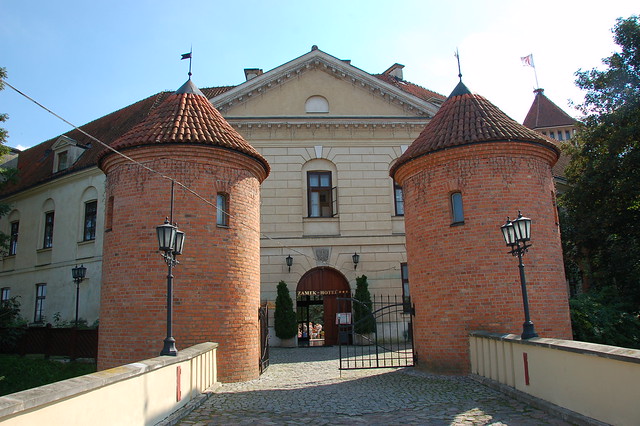Pułtusk

The former bishopric of Pułtusk. – Photo by: Krzysztof Belczyński on Flickr: https: //www.flickr.com
Distance
Population
19.240 (2013)
Location and history
Pułtusk is located in the east-central part of Poland, north of the capital Warsaw.
In the place where the castle of Pułtusk now lies, in the first half of the 13th century. built a fortified settlement. This settlement (mentioned for the first time in 1227) was granted market town rights twice, first in 1257 by Prince Siemowit I, second time in 1339 by the Bishop of Płock, Klemens Pierzchała.
From the 13th to the 18th year. was Pułtusk owned by the bishops of Płock, who resided on the castle of Pułtusk.
It was the third city in Mazowsze – after Warsaw and Płock, that got ground-walled defenses. Economically, the city developed in the 14th-16th century, – mainly because of grain trade.
From 1508 a defensive wall began to be erected around the city.
During the Third Nordic War, in 1703, a battle was fought at Pułtusk between Karl XII of Sweden and Saxon forces. In 1806, a bloody battle at Pułtusk was fought between the French forces under Napoleon Bonaparte and the Russian army. Napoleon stayed in Pułtusk in 1806 and 1812.
In January 1868, a meteorite descended near Pułtusk; however, it was burst into thousands of pieces in the atmosphere and therefore hit the ground like a meteor shower, the most extensive ever recorded.
In 1875, the city was ravaged by an extensive fire. On-site author Henryk Sienkiewicz described the tragedy in the press and later used his impressions of the fire in his novel “Quo vadis”.
During World War II, large parts of Pułtusk were destroyed. In 1958 and 1979 large floods occurred in the city.
Tourist attractions
Pułtusk is one of the oldest cities in Mazowsze.
Square
The long paved square in the old town is believed to be the longest in Europe.
Borgen
The diocese castle, located on the banks of the river Narew, can trace its history back to the 15th century. The castle itself and the defense works were expanded several times over time. Now it appears as a castle with the buildings forming a semi-circle and the main entrance flanked by two round defense towers. The complex, which is surrounded by the castle park, is called today “Dom Polonii” and has hotel features.
Mary Annunciation Basilica
is the main church in Pułtusk. It was founded in 1449 in Gothic style and today appears as a three-ship building. The church's monstrance and relic gems as well as the Gothic altar are all from the 1400s.
City Hall
with the huge town hall tower (over 30 meters high) is from the 16th century. in Gothic-Renaissance style. The tower today houses a regional museum.
The town of Pułtusk is mentioned in Henryk Sienkiewicz’ novel “Potop”.
Surrounding Area
rivers :
Narew
Pułtusk is located (mainly) on the west bank of the Narew River. The old town is surrounded by water, with Narew off the town forming two river arms – one western and one eastern – which surrounds the old town, and which north of the town gather in one river arm further north to the main stream. The eastern river arm even forms its own river arm to the northeast.
bug
25 km south of Pultusk, at Serock, the Bug river has its outlet in Narew.
landscape Parks :
On the eastern river bank, adjacent to the town, lies Bug Landscape Park. The park extends over approx. 1000 square kilometers and includes 14 nature reserves.
Accommodation
Booking.com
Pułtusk (The city's website in Polish, English, German, French and Russian)
Eating Out:
Pułtusk (The city's website in Polish, English, German, French and Russian)
Other Internet sites and sources
Pułtusk (The city's website in Polish, English, German, French and Russian)
Translated into English by Google Translate. Spangshus.dk accept no liability for any errors or omissions in translation.
Map

Rating
Search
Most used tags
churches (205) Castles (86) Monasteries (79) Town walls (74) Lakes (71) Town halls (67) Rivers (65) Castles1 (62) Mansions (55) Museums (51) Regional museums (38) Town gates (36) Abbey churches (35) Castle ruins (30) Cathedrals (26) Forests (25) Health resorts (24) Water sports (23) Mounds (23) National parks (22)Click for all tags
Denne side er også tilgængelig på dansk. This page and contents is (c) Copyright 2018- www.spangshus.dk. Based on Inviator software by ISCA Software